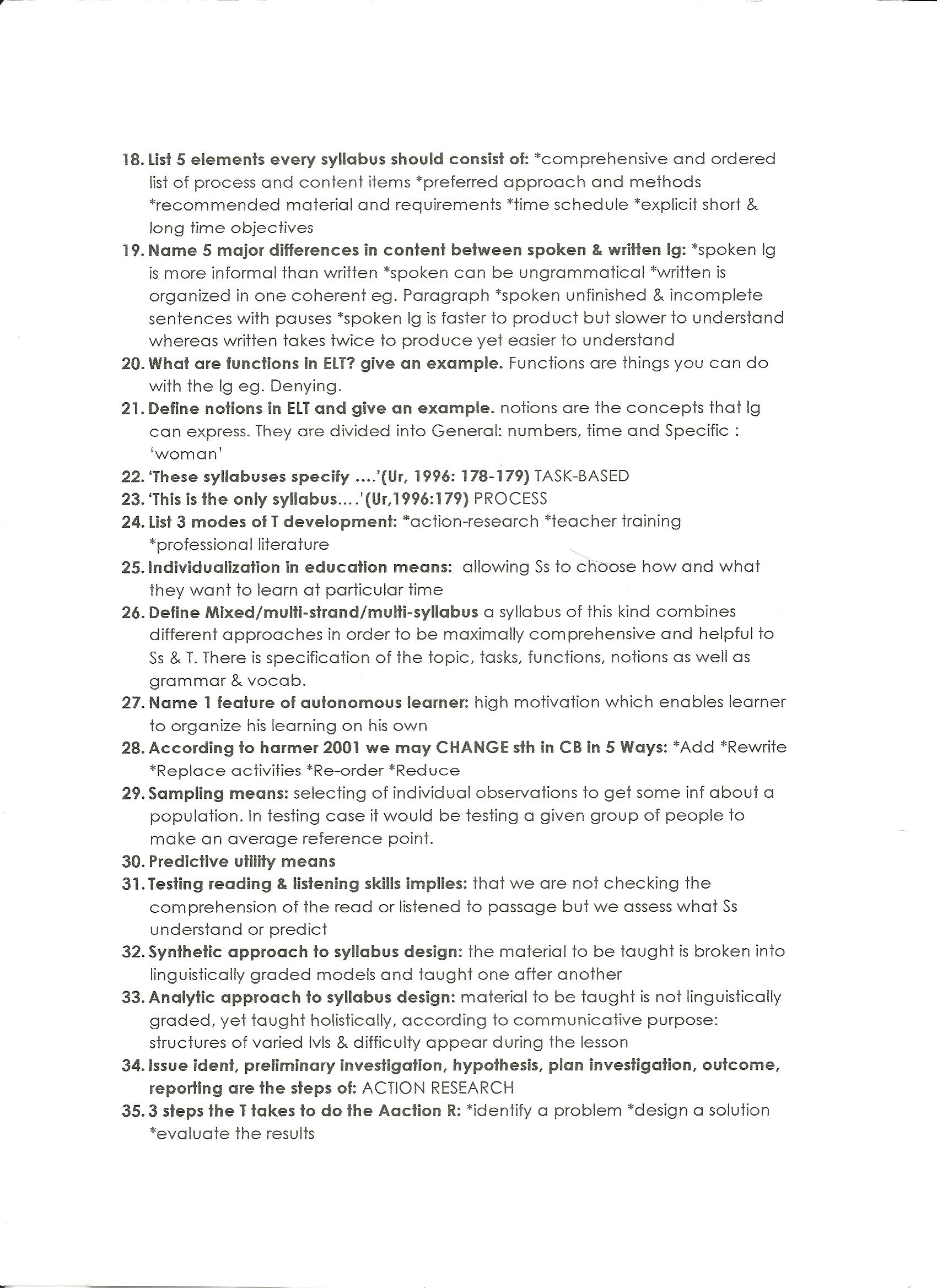Metodyka 2

18. List 5 elements every syllabus should consist of: *comprehensive and ordered list of process and content items *preferred approach and methods *recommended materiał and requirements *time Schedule *explicit short & long time objectives
19. Name 5 major differences in content between spoken & written Ig: *spoken Ig is morę informal than written *spoken can be ungrammatical *written is organized in one coherent eg. Paragraph *spoken unfinished & incomplete sentences with pauses *spoken Ig is faster to product but slower to understand whereas written takes twice to produce yet easier to understand
20. What are functions in ELT? give an exampie. Functions are things you can do with the Ig eg. Denying.
21. Define notions in ELT and give an example. notions are the concepts that Ig can express. They are divided into General: numbers, time and Specific : 'woman'
22. ‘These syllabuses specify ....’(Ur, 1996: 178-179) TASK-BASED
23. ‘This is the only syllabus... .'(Ur,1996:179) PROCESS
24. List 3 modes of T development: *action-research *teacher training *profes$ional literaturę
25. lndividualization in educałion means: aliowing Ss to choose how and what they want to learn at particular time
26. Define Mixed/multi-strand/multi-syllabus a syllabus of this kind combines different approaches in order to be maximally comprehensive and helpful to Ss & T. There is specification of the topie, tasks, functions, notions as well as grammar & vocab.
27. Name 1 feature of autonomous learner: high motivation which enables learner to organize his learning on his own
28. According to harmer 2001 we may CHANGE sth in CB in 5 Ways: *Add *Rewrite *Replace activities *Re-order *Reduce
29. Sampling means: selecting of individual observations to get some inf about a population. In testing case it would be testing a given group of people to make an average reference point.
30. Predictive utiłity means
31. Testing reading & listening skills implies: that we are not checking the comprehension of the read or listened to passage but we assess what Ss understand or predict
32. Synthetic approach to syllabus design: the materia! to be taught is broken into linguisticaliy graded models and taught one after another
33. Analytic approach to syllabus design: materiał to be taught is not linguisticaliy graded, yet taught holistically, according to communicative purpose: structures of varied lv!s & difficulty appear during the lesson
34. Issue ident, preliminary investigation, hypothesis, plan investigałion, outeome, reporting are the steps of: ACTION RESEARCH
35.3 steps the T takes to do the Aaction R: *identify a problem *design a solution *evaluate the results
Wyszukiwarka
Podobne podstrony:
img063 63 Rozdział A. Nieliniowe sieci neuronowe klasycznej metody backpropagalion z wykorzyslniem e
img063 63 Rozdział A. Nieliniowe sieci neuronowe klasycznej metody backpropagalion z wykorzyslniem e
img146 146 10. Metody ciągowe list - lista tworzona w czasie rozpoznawania, w której pamiętane są ko
img162 162 11. Metody drzewowe a pozostałe elementy są następujące:Et = {1,0}, ZN = {A,B,C,D,E,Z,W},
Metodologia I - metody badań ilościowych z elementami statystyki dr hab. Piotr Wolski mgr Mateusz
METODY I TECHNOLOGIA WYTWARZANIA ELEMENTÓW OPTYCZNYCH Z TWORZYW SZTUCZNYCH 1.
Metody Itechniki badań z elementami metodologii badań w pedagogice Sylwia Opozda-Suder
Metody numeryczne 1. Metoda elementów skończonych MES wymaga podziału zęba na
zginanie teowy wymiarowanie metodą uproszczoną Rysunek 4.27. Algorytm wymiarowania zbrojenia wed
ĆWICZENIA REWALIDACYJNE (18) Wytnij elementy i ułóż z nich domek. Przyozdób zielenią.
zbrojeniesymetrycznesciskanie Rysunek 5.20. Algorytm wymiarowaniu zbrojenia symetrycznego według met
więcej podobnych podstron